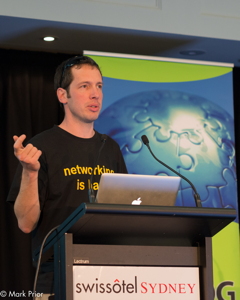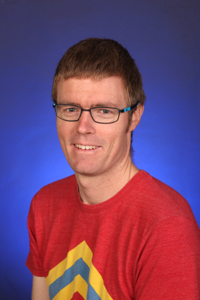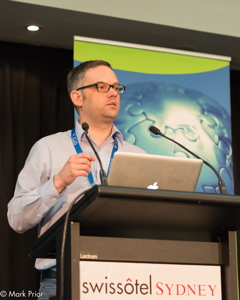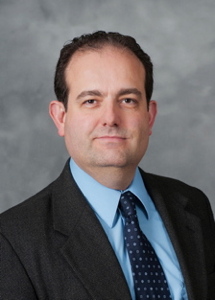Aijay Adams - Facebook
Untrusting the Network

There is a plethora of information available from the devices which make up Facebook's global datacenter and backbone networks, our devices report thousands of counters, some obvious in function, others less so. Despite our best efforts to collect and correlate, we still found that our network elements had a real knack for failing in creative ways which evaded traditional device counters and metrics.
In response to this situation Facebook has deployed monitoring across our network based on one core principle, don't trust the network. By monitoring on production paths through devices we are able to know how the network is really performing.
We have developed a number of tools which specialize in this large scale, end to end monitoring and fault isolation. The best part? much of the platform has been open-sourced so you can build on it for your own networks!
Paul Brooks - Trident Subsea Cable
Optical Communications - where Physics beats Standards
Standards specifications, developed within respected international organisations such as the ITU, IEEE, ANSI, and IETF, are often thought to be crucial in enabling communications networks to be constructed, and for equipment from different vendors to interoperate. We like to claim that through use of common standards, global networks can be built to carry communications around, above, or below the planet.
In optical networking however, technology breakthroughs are being developed- and deployed in operational networks – far in advance of any established standards. Meanwhile, some of the published standards cause more confusion than cohesion, and make themselves obsolete with no practical application.
In this session I outline some of the latest developments in optical networking – and explore the scandalous world of networking without standards, and standards without any networks.
Biography
Paul leads the technology team at Trident developing a new subsea optical fibre cable from Perth to Singapore.
Sometimes described as a "Serial CTO", Paul has over 20 years direct experience in domestic and international carriers, wide-scale residential NGN access network deployment and broadband video delivery, with executive technical leadership roles in global carriers such as Global One/Sprint International, and Australian service providers including TransACT Communications, Basslink, Vocus Communications and other start-ups.
Including this one, Paul has spoken at at least eight AusNOGs, attended nine, and collected every AusNOG t-shirt since inception.
Dylan Chidgey - Cirrus Communications
Fixed Point Wireless: Raising the Service Level
The journey of transforming Cirrus Communications network from providing regional residential broadband to servicing businesses and wholesale providers in both metropolitan and regional centres. How the various challenges have been addressed in order to provide the current service level and move it to a higher level.
Xiaohong Deng - University of New South Wales
Rethinking Broadband Performance Comparison using Big Data from M-Lab

Broadband network performance is multi-faceted, dependent on factors such as access link characteristics, speed-tier, server distance, host buffers, ISP network dimensioning, and time-of-day. Daily or monthly aggregates, published by content providers such as Netflix and Youtube, present a highly simplified view that do not distinguish the impact of the above factors, making the comparisons potentially unfair and incorrect. Our paper revisits broadband performance using open data from M-Lab, utilizing nearly 5 million measurements taken over a 12-month period across 19 ISPs in 3 continents. We first develop a tool that allows a non-expert to query, process, and visualize M-Lab data by applying various filters and granularities via a simple web-based interface. Using this tool, we characterize the influence of the various factors, and find that there are significant biases affecting the averages, including disparities amongst households in their frequency of testing and access speed-tier, that contribute to fluctuations and biases in ISP performance comparisons. We then apply statistical and causal inference techniques to reduce the sampling bias, and find that the disparity amongst ISPs is lower than current averaging methods indicate, with hourly variations giving a truer indication of well-dimensioned ISP networks.
Biography
Xiaohong is a Ph.D candidate and causal academic stuff with UNSW, with research interests in Machine Learning and it's application to network measurement data, IoT data and security data.
Prior to UNSW, Xiaohong has been working in IT in different roles since 2007: Software Engineer, Project Lead, Technical Trainer, and CEO of an on-line education startup. The longest serve was to France telecom from 2008 to 2013 as a Network Architect and Project Lead. Previously based in China, France and now in Australia.
She has co-authored several RFCs (Internet Standards) related to IPv6 transitioning. Led a number of open-source projects in the very same field, which obtains usages from over 70 countries globally. Filed 2 PCT Patents.
Zen practitioner. Dance, swim and skiing lover. Certified Guzheng player. Have a thing about poems and the art of living.
Jamie Horrell - IDC
AUSNOG Archaeology - Natural Language Processing and xNOG Mailing Lists
Network operators groups provider valuable archives of mailing lists providing a plethora of unstructured data well suited to analysis using Natural Language Processing (NLP) tools. This talk will explore the history of the list and compare it to other groups around the world.
Insights of the list across time will include:
- The rise and fall of interest in technical and regulatory topics
- The activity of the list
- The most emotive topics
- Sentiment of the list in general across time
Biography
Jamie is the Research Manager for connectivity and compute at IDC Australia, he has interests in data analysis, Internet operations, telecommunications and natural language processing.
Beatty Lane-Davis - Infinera
Multi-layer path computation

Traffic engineering is a complex topic. It was hard in native-IP networks and while MPLS provides all the hooks for TE, it's still challenging to get right in a distributed fashion. This has resulted in a high percentage of MPLS networks running RSVP-TE, but very few using RSVP-TE for actual bandwidth reservation.
This talk will look at the inherent challenges of TE, look at its evolution, and dig into the current standards work aimed at tackling these problems once and for all. Finally we will consider how taking a multi-layer approach to traffic engineering can provide optimal efficiencies in network resource utilization.
Dion Leung - Coriant
Optical Transport Technologies for Data Center Interconnection (DCI)
New breeds of optical technologies have changed the way how data centers are connected to each other. While dark fibers might still be popular and provide cost effective medium to connect data centers in a point-to-point fashion, in some Asian countries, such as Japan, Singapore and Hong Kong, dark fibers are in high demand among content providers, internet service providers and network service providers. Especially for some colocation providers, a well-designed DCI network has become an important part of their business that foster new business innovation and ideas.
The session is designed for audience who has little or no optical knowledge or exposure to the subject of optical networking. It covers some fundamental concepts, explaining the essential 'lego' blocks for designing an optical network as well as upcoming future trends in optical technologies for DC interconnection.
Matthew Luckie - CAIDA
Update on CAIDA spoofer project

Despite source IP address spoofing being a known vulnerability for at least 25 years, and despite many efforts to shed light on the problem, spoofing remains a viable attack method for redirection, amplification, and anonymity. Recently, CAIDA took over stewardship of the spoofer project, with the goal of increasing the density of crowd-sourced measurement of ingress filtering, and publicly providing evidence of where remediation attention should be focused. In this talk, I will discuss the new measurement system we developed, present the public reporting website, and discuss methods to infer lack of ingress filtering of customer ASes by provider ASes using publicly available data.
Terry Manderson - ICANN
KSK Rollover Plan
IANA/ICANN/PTI has prepared a plan to change the Root Zone DNSSEC KSK. This talk will present highlights of the plan to explain what will be happening, why this is important to follow, and what the audience needs to do as a result.
Tom Paseka - Cloudflare
Monitoring and Automation of a Global Network
In this talk, Tom would like to explore the work the CloudFlare team has done to automate management of its 80+ edge locations. Tom will explore the work CloudFlare has done in using Netconf, Salt and monitoring tools to determine the stability of underlying Internet backbone paths and how routing and anycast is managed at the edge of the network to handle failures and outages.
Tony Scheid - Arbor Networks
Defending Olympus: Mitigating a Sustained 540gb/sec DDoS Attack Campaign
In this presentation, we will discuss DDoS attack methodologies, DDoS mitigation strategies, and deltas of general Internet traffic patterns associated with a major international athletic competition.
Darin Sikanic - Brocade
Auto remediation of networking systems failures: Operations Automation - What's the time? Its NETDEV time!
Companies such as Facebook and Netflix have driven down the cost of operating their networks by typically having very few Ops engineers on call. This is made possible by automating manual procedures and workflows. Network automation isn't as "black arts" as it once was, and doesn't require a whole team of crazy developers to accomplish. In this talk we will discuss and demonstrate how simple it now is to remediate some typical network failures without human intervention, from the simple BGP peering failure to more complex failure scenarios involving multiple variables or complete systems failure.
Mark Smith
The Trouble with NAT

NAT has been widely deployed in IPv4 networks since its invention in 1994. My first experience with NAT was in 1995, where I failed to successfully deploy it for a customer due to one of its intrinsic limitations. Since then I've encountered or discovered other NAT limitations.
Avoiding these NAT imposed limitations have been one of my main motivations to work on and advocate the deployment of IPv6.
I've also since realised a set of network characteristics that I consider to be essential to the successful operation of a network.
In this presentation I'll first present and discuss these network characteristics. We'll then look at the various limitations that NAT imposes in the context of these essential network characteristics.
Biography
Mark started working in the industry in the early 1990s. He has held a variety of positions, starting in desktops and servers, and then changing to networking in 1998. He has experience at public and private enterprises, system and network integrators, telcos and ISPs. Most recently he has been working on smart meter networks in the utility sector.
Mark has been participating in the IETF since 2002, primarily the IPv6 related Working Groups.
Mark is also past presenter at AusNOG, having presented at 4 of the past 5 conferences.
Elly Tawhai - APNIC
APNIC Update: IPv4 waiting list
This is a short presentation to cover the implementation of the IPv4 waiting list, and how it will impact the Australian network operations industry since APNIC can no longer fulfil IPv4 requests from the recovered pool. Included are statistics covering the amount of IPv4 and IPv6 address space delegated within Australia, and to help put into perspective for the percentage whom have not received IPv6 address space that it is the future for network development.
Katsuyasu Toyama - Chair of APIX association/COO of JPNAP
Internet Exchanges in Asia Pacific
In Asia Pacific region there are approximately 80 or more internet exchanges. The presenter is acting as a chair of APIX, an association of internet exchange operators in this region. APIX consists of 22 IX operators from 15 countries and economies.
In this presentation he will give a talk about comparison among IXPs in Asia Pacific, as well as those in other regions like Europe, Latin America, Africa, and North America. Also current peering scene and outstanding issues for IXPs in this region.
Comparison will be used some Key Performance Indicators such as number of ASN, peak traffic, and average traffic per ASN. They indicates how many ISPs you could peer, how much traffic could be distributed, and how big is each ISP in the IXP, respectively. Not only ranking in Asia Pacific IXPs but also he compares them with some famous IXPs in other regions, figuring out some features in each region.
The current peering scenes and outstanding issues will be presented by picking up some example countries like advanced countries and developing countries. In particular Japan is mature broadband market and 4 commercial IXPs are competing with each other, so he will give a talk on it. With regard to outstanding issues, he will also present operation experiences at JPNAP, the biggest internet exchange in Japan.
Biography
Katsuyasu Toyama is a chair of APIX association and COO of JPNAP, the biggest internet exchange in Japan, by INTERNET MULTIFEED CO. He was involved with the establishment of the company, in 1997, and there he designed JPNAP network and services in 2000. After leading a research project on IPv6 and security at NTT Labs., he has been working as Director of JPNAP since 2007, and also worked at NTT Communications from 2012 to 2015 to be responsible for all the Internet business on eyeball networks in Japan and ip transit service all over the world.
Usen Tulemisov - Cisco Systems
Data analytics approaches to assist Network & Security Operations

Exponentially growing network environment, constantly evolving attacks and extremely scarce resources demand new ways to ensure productivity in Service Provider networks. This session will provide a review of impacts and outcomes associated with utilising massively distributed analytics architecture to assist next generation network & security operations.
Biography
Usen is a Senior Systems Engineer in the Service Provider team at Cisco Australia. Usen holds a PhD in Information Systems, an MBA in General Management and has over a decade of experience working in IT and Telecommunications, assisting organisations develop and implement technology strategy in Internet, Cloud, Media and Utilities service provider markets.
Christian Urricariet - Finisar Corporation
Latest Trends in Data Center Optics

The data center ecosystem is going through unprecedented growth and innovation as new players, new business models and new technologies converge. One of the trends is the growing importance and evolving landscape of fiber optic technologies enabling new architectures and enhanced levels of performance for both data centers and service providers. High bandwidth, increased port density and lower power dissipation are now key requirements for Ethernet router, switch and server I/O.
The talk covers the latest industry trends in optical interconnects, including:
- Significant increase in 25G and 100G port density.
- Extension of optical link types beyond the Standards.
- Reutilization of 10G fiber plant for 40G/100G.
- Moving beyond 100G towards 200G and 400G.
- Introduction of Open Optical Monitoring.
Biography
Christian Urricariet is Senior Director of Marketing for data center and service provider solutions at Finisar. Since joining the company in 1999, he has held a variety of product management roles encompassing 400G, 100G, 40G, 10G, 2G and 1G optical product lines. Prior to joining Finisar, he held several telecom product marketing positions at Raychem Corporation. He holds an Electronics Engineering degree from the Buenos Aires Institute of Technology (ITBA).
Ken Wilson - Opengear
Central orchestration of network infrastructure - devops meets netops

Over the last decade, configuration management and monitoring of servers has moved from bespoke scripts to sophisticated central orchestration and automation systems, such as Chef, Puppet, and Ansible. These systems allow configuration changes to be rolled out in a automated, reliable, and audit-able manner. Recently a number of these systems have been extended to provide support for networking device configuration.
This talk will look at the bindings provided by some of the major orchestration systems, and some of the challenges these systems face to gain acceptance in the networking world.
Biography
Ken Wilson heads up the software development team at Opengear and is responsible for everything from bootloaders and kernels to fluffy management software. During his time at Opengear, he has supervised the design, development and rollout of new generations of hardware appliances for data centre and remote site device management, as well as managing the development of several custom products for OEMs.
Prior to Opengear, Ken worked for SnapGear building firmware for UTM Firewall/Routers and for CiSRA (Canon Information Research Australia), working on print rendering technology.
Ken has a degree in Software Engineering from UQ.
